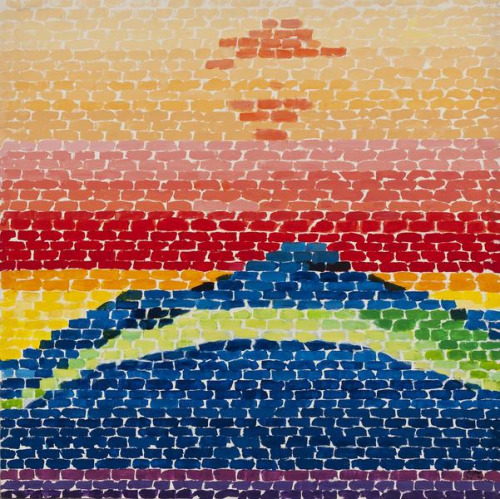 |
| Alma Thomas, Apollo 12 "Splash Down", 1970, acrylic and graphite on canvas, 50.25 x 50.25 inches. Image via tang.skidmore.edu; courtesy of Michael Rosenfeld Gallery, NY. |
February 6 - June 5, 2016
THE FRANCES YOUNG TANG
TEACHING MUSEUM AND ART
GALLERY AT SKIDMORE COLLEGE
815 North Broadway
Saratoga Springs, NY
From tang.skidmore.edu:
Alma Woodsey Thomas (1891 - 1978) is known for her vibrant, colorful paintings. A black woman who grew up under the racial violence of Jim Crow and experienced the Civil Rights Movement firsthand, she did not seriously pursue an artistic career until her retirement at age 69. She resists conventional categorization, whether as an Abstract Expressionist, a Washington Color School painter, or as a female or black artist. Instead, they reveal an artist negotiating her own space amid Washington, D.C.’s, artistic movements, both white and black, of the mid-twentieth century. Frequently included in group exhibitions, she has not been honored with a solo show since 2001.
Born in Columbus, Georgia, Alma Thomas moved with her family to Washington, D.C., in 1907 to escape Atlanta’s erupting racial tensions and so that she and her three younger sisters could receive a better education. She attended Howard University from 1921 to 1924, and then worked until 1960 as an art teacher at a local junior high school. She received her master’s in art education from Columbia University Teachers’ College in 1934. Beginning in 1950, Thomas enrolled in American University, earning her MFA in painting in 1960. In 1972, at age 80, she became the first black woman to have a solo exhibition at New York’s Whitney Museum of American Art.
Thomas actively participated in the art world throughout her life, despite her late entry into professional painting. She remained friends with James V. Herring, the founder of Howard University’s Art Department and one of the founders of Howard’s Barnett Aden Gallery. In the late 1940s she participated in Lois Mailou Jones’s Washington salons for black artists, and was close to Jacob Kainen, with whom she studied at American University. She is frequently cited as a member of the Washington Color School and her work maintains a dialogue with artists and critics such as Morris Louis, Kenneth Noland, Howard Mehring, Gene Davis, Clement Greenberg, and Sam Gilliam.
In her mature style, bright primary colors fill Thomas’s paintings; they are indicative of her study of Johannes Itten, her visit to New York’s Museum of Modern Art’s 1961 exhibition of Henri Matisse’s cut outs, and the work of artists, such as Josef Albers and Wassily Kandinsky. Her visible, regular brushstrokes display the hand of the artist, differentiating her work from the flatness of the Washington Color School. Instead, she paints loosely but constructs her canvases carefully, filling the surface with a dense latticework of color, with subtle patterns emerging from the remaining white spaces. The tensions emerge from the interactions of the bright colors, her brushstrokes, and the negative spaces, creating a continual but controlled sense of movement, an almost musical or dance-like rhythm.
Thomas grounds her paintings, though abstract, in the natural world, evoking leaves, flowers, light, and air. She cites as inspiration "watching the leaves and flowers tossing in the wind as though they were singing and dancing," a reference to a frequent subject of her work, a holly tree outside her window whose leaves created an ever-present play of light.
During the late 1960s and early 1970s, Thomas’s work became increasingly popular, prompting laudatory reviews from critics, including Harold Rosenberg. These reviews described her paintings as “shimmering with color” and admired her for painting “with a verve, an unjaundiced eye, a freedom that is given to few.” Other critical responses have considered the role of her sex and race, investigating her ability to excel at a time and within a style that had been previously dominated by white men.
The exhibition Alma Thomas is organized by The Tang Teaching Museum and Art Gallery at Skidmore College and The Studio Museum in Harlem. The show will open February 2016 at the Tang and be on view at the Studio Museum in Summer 2016. Additional traveling venues to be announced. The exhibition is curated by Ian Berry, Dayton Director of the Tang Museum and Lauren Haynes, Associate Curator, Permanent Collection at the Studio Museum. A major catalogue will accompany the exhibition with extensive images and new essays on Thomas's important work and influential legacy.
No comments:
Post a Comment